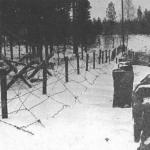Of course, the main component of a sandwich panel is its insulation. It is he who determines how comfortable winters will be in your home. The insulation must meet the following requirements:
- Have very significant thermal insulation properties;
- If possible, have minimal weight;
- Have a high strength index;
- Be able to maintain its characteristics even at high humidity levels;
- Tolerate low and high temperatures without problems;
- To be completely safe for humans, that is, not to contain harmful substances and not to burn;
- To be durable, that is, not to lose its properties over time;
- Have a low cost.
The modern market offers insulation with sandwich panels that have mineral wool, polystyrene foam or polyurethane foam in their construction. A panel with one or another insulation has both disadvantages and advantages. Panels with polyurethane foam have ideal thermal insulation properties, but are quite expensive, and therefore are used only in specialized premises and freezers. Private construction is carried out mainly using mineral wool and expanded polystyrene.

The main advantage of mineral wool is its resistance to fire. Polystyrene foam has a wider list of advantages: environmental friendliness (98 percent of it consists of air), low thermal conductivity, low weight, highest performance, unpretentiousness, durability and minimal production time.
Mineral wool has a lot of disadvantages. It absorbs excess moisture, which leads to subsidence, damage to the integrity of the structure and freezing. Installation of mineral wool is quite difficult, and the large mass leads to an increased load on the foundation. The disadvantage of polystyrene foam is its low degree of fire resistance.
Using sandwich panels with mineral wool relevant, first of all, in structures that require maximum protection from open flames. The majority of people fall into this category prefabricated buildings. It is absolutely not advisable to use panels with mineral wool in car washes, refrigerators, and food processing plants. Foam panels are perfect for the reconstruction and construction of buildings, regardless of their purpose. Mainly, this group consists of buildings that require ideal moisture resistance, hygiene, practicality and minimal cost. If we talk about the ratio of quality and price, then foam-based panels can be called the most reasonable option. They can be safely used in all buildings whose roofs and walls belong to the second or higher fire resistance categories.
Sandwich panels are produced by manufacturers ready-to-use, so the issue of finishing in some cases does not arise at all. For example, during construction production premises. The product is a three-layer structure consisting of two sheets of galvanized steel and a heat-insulating layer between them. Basalt wool or foam is used as insulation. synthetic materials: expanded polystyrene, polyurethane foam and others.
The front surfaces can be smooth or grooved, coated with polymer resins. Due to this, the slabs are produced in various colors, which allows you to create interesting geometric combinations on the outside of the building. Developers take advantage of this quality industrial enterprises, so as not to additionally solve the question of how to finish the sandwich panels. It's a completely different matter when it comes to the construction of private houses. If you can still get by outside appearance the slabs themselves, then they should certainly be closed indoors.
Area of use

Sandwich panels are used in construction frame houses, as a filler between drains and cross members of the main frame. They are used for exterior finishing as self-constructed or as part of a suspended ventilated facade. This material serves as both insulation and cladding. There are special three-layer roofing products. Both of them are equipped with all kinds of additional elements and layouts, so that during installation you can close the joints and decorate the edges, corners, and transitions. In addition, the products themselves are produced with tongue-and-groove locks, so they are easily and tightly mounted. They can be attached to the sheathing or to a flat surface, if it is level.
Recently, insulated slabs have become often used for interior work. They make them internal partitions, stationary and mobile, they are used to insulate external walls from inside premises, as well as balconies and loggias. It has become especially popular to use sandwich panels for finishing windows, or rather, slopes. In this case, sandwiches are used with outer layers not of metal, but of plastic and with more thin layer insulation.
Slope cladding

With the advent plastic windows The problem immediately arose as to how and with what the finishing of the slopes should be done. We tried everything - high-quality plaster, and plastic panels and many other options. But the most The best decision came with the advent of three-layer material. Finishing with sandwich panels window slopes At the same time it eliminates “cold bridges” and gives the window opening a complete look. The work is simple and quite affordable to do it yourself. The cladding of window slopes should be done before finishing the walls. These works are done in this order:
- all surfaces around are cleaned window frame from dust, dirt, solution build-up;
- a window sill is installed; Most often, a solution based on cement and lime is used for this; to avoid sagging, metal strips are laid under the window sill, and for insulation, the lower part and sides are wrapped in felt; Before use, the insulation is impregnated with an antiseptic to prevent it from rotting and the appearance of insects;
- sealing of voids and junctions of the window and window sill to the opening is carried out polyurethane foam; frozen foam cut with a paint knife flush with the main surfaces;
- The sandwich panel is cut according to preliminary measurements of the top and sides; the material can be cut very well with a jigsaw or metal file;
- work begins from the upper slope: the starting slope is attached to the frame with self-tapping screws plastic profile, into which the sandwich is inserted the right size with a slight slope; the internal gap is filled with polyurethane foam or liquid nails and pressed against the wall;
- the side parts of the slope finishing are fastened in a similar way; you need to ensure that the slopes fit tightly to the sides of the opening, and excess adhesives should be removed immediately and thoroughly;
- They finish lining the slopes with sandwich panels by attaching the finishing frame in the form of corners to liquid nails.
There are other ways to install window slopes using brackets, sheathing and other devices. But these methods are more complex and time-consuming. They are used in special cases when the design of the window opening or frame requires it.
From the above it is clear that doing the installation work of installing the window sill and slopes on the windows yourself is not such a terrible problem. Moreover, this method of protecting a window opening is successfully used not only for plastic frames, but also for wooden ones. This means that you can build a beautiful frame for a window block without changing the window itself. Moreover, manufacturers have learned to design the front surfaces of sandwiches in the most different colors and shades, including “wood, marble, granite.” The plastic used is glossy, semi-gloss, matte. Cladding with sandwich slabs window openings can be matched to any interior style.
Interior wall decoration from sandwiches

The premises of frame houses, the outer walls of which are made of “sandwich” slabs, are undoubtedly subject to interior decoration. Since the panel itself inside the room will look too dull and official. At the same time, methods and materials can be absolutely any. Will only be needed for finishing preliminary preparation. Let’s say it’s impossible to paste wallpaper onto sandwiches. Therefore, first you will have to cover the walls with plasterboard. It may be necessary to accept additional measures For better insulation walls For this purpose, a layer of insulation is laid between the frame profiles, and then it is covered with sheets of plasterboard. The following is the standard procedure: sealing the joints with putty with reinforcing tape, grouting the heads of the screws and wallpapering, tiling, textured plaster, painting over finishing putty.
Some interior styles require the presence of a large amount of wood. In this case, the owner of the house can use his talent and cover the walls with beautiful lining, imitation timber, and wooden wallpaper. To do this, you need to arrange a frame of beams along the surfaces of the walls, arranging them in such a way that the cladding lies as intended - in a vertical or horizontal position. If the building is built in a frame version and does not require additional insulation, then it is not necessary to install a sheathing, and the wooden cladding can be attached to the frame posts. All work can be done with your own hands, showing maximum imagination. The main thing is to select materials with taste and install them according to all the rules of finishing art.
Facade facing thermal panels are presented in the form of special structures that perform two important tasks - they insulate the facade of the house and are a finishing material.
Thermal panels - facade decorative elements
Metal and rusticated facade panels have gained well-deserved popularity due to their relatively low cost and high speed of construction. installation work.
1 Features of facade thermal panels
It’s worth mentioning right away that the presented metal and rusticated facade panels of the Rockwool brand represent the most rational and environmentally friendly solution to the thermal insulation issue.
Before you start insulating the outer surface of your house with a product such as a façade sandwich panel, you should take into account that it can be compatible with any surface, be it stone or brick.
Insulating the facade of a house with Rockwool brand sandwich panels will give top scores, if they are secured to an additional layer of foam.
By the way, unlike foam plastic, Rockwool sandwich panels, stylized as stone or brick, significantly improve not only the heat-saving qualities of the facade, but also increase its aesthetic appeal.
In addition, the Rockwool sandwich panel can be attached to the outer surface of the facade (as opposed to foam plastic) on surfaces such as:
- Concrete;
- Expanded clay concrete;
- Classic brick on ;
- Plastered facade;
- Unplastered facade;
- Wall of a block house;
- Aerated concrete;
- Tree;
- Unfired raw brick.
Thermal panels, stylized as stone or brick, mostly have positive reviews, which is associated with a certain number of advantageous features.
For example, this may be the possibility of insulating old buildings with sandwich panels. Products such as rusticated thermal panels can, if necessary, insulate the facade of a house with a broken geometric shape.

It is almost impossible to carry out such insulation work using ordinary polystyrene foam. In particularly difficult cases, in order to insulate the uneven facade of the house, instead of polystyrene foam, it is first finished with lathing, which levels the working surface.
After this, the facade is covered with thermal panels or sandwich panels, which can be stylized as stone or brick.
2 Characteristics and properties of thermal panels
When finishing the outer surface of the facade with thermal panels, the period of installation work is significantly reduced.
In turn, this significantly reduces total time, which was spent on carrying out construction work, and as a consequence their cost.
It is known that when carrying out construction work, a significant share of the costs is not only the purchase of materials and wages, but also rent scaffolding, with the help of which facade work will be carried out.
Installation of a thermal panel does not require the involvement of highly qualified workers and specialists, because you can do it yourself without much difficulty.
For this, by and large, you will need minimum set the most common tools. During installation you cannot do without:
- Electric drills;
- Construction knife;
- Hammer;
- Screwdrivers as shown.
Before you start installing insulation, you need to make sure that the surface of the walls is smooth and free of significant flaws.
Facade panels can be secured using glue, polystyrene foam or dowels. It is known that the presented panels cost significantly less than traditional brickwork, therefore, after carrying out simple calculations, you can find out the percentage of cost savings when carrying out insulation in this way.
The insulation, presented in the form of thermal panels, completely relieves the owner of the mandatory need associated with periodic repairs of the facade and restoration of the outer surface of the walls.
However, if the work is carried out without complying with the technology requirements, the insulating coating may be subject to deformation.
The presented material has a long service life, which is equal to more than fifty years, while maintaining the original color.
2.1 Product reviews
As already mentioned, reviews of facade panels with insulation are mostly positive.
Pavel, 45 years old, Izhevsk:
I recently purchased a resale home Vacation home. I decided to make it major renovation before check-in. When it came to insulating the facade, I bought and installed Rockwool thermal panels. Excellent insulation and, moreover, pleasing to the eye.
Sergey, 50 years old, Kramatorsk:
Lately I've been getting old heating system began to cope with her task poorly. I took up the external insulation of the facade. Rockwool sandwich panel was used as insulation. Now in all rooms optimal temperature. I recommend this insulation to everyone.
Vladimir, 43 years old, Zhitomir:
I am the foreman of a small construction team. We work mainly on private orders. When it comes to external insulation of house facades, we use Rockwool thermal panels. These products have long proven themselves to be the best. Customers are always satisfied, the material is excellent, we have no complaints about its quality.
2.2 Clinker thermal panels
The presented type of panels has clinker tiles as a decorative layer. If we talk about the degree of resistance to aggressive influences environment, then clinker is superior in performance to some types of natural stone.
This material has a large number of colors and is made using slate clay. Such raw materials are currently mined in Northwestern Europe.
This suggests that clinker is an absolutely environmentally friendly material that does not contain harmful chemical additives or impurities.
It is created by implementing the high-temperature firing method. Clinker panels exhibit high performance mechanical strength, with a low water absorption value.
This material is characterized by pronounced frost resistance and the ability to retain its properties throughout its entire service life.
In addition to the fact that clinker panels exhibit excellent thermal insulation and aesthetic properties, they demonstrate high noise insulation qualities.
In addition, the material acts as additional waterproofing. This material is used not only as insulation and decorative element facade, but also for interior finishing work.
2.3 Thermal panels with porcelain tiles
Ceramic granite is another type of insulation ceramic tiles. It is made from high-quality raw materials, during the process of firing, exposure high temperatures and pressure.
The result is a very densely compressed material that is practically immune to harmful environmental influences.
These indicators significantly exceed natural natural stones. The presented thermal panels are especially appreciated by those home owners who prefer to design a façade that has a detailed textured surface.
Thermal panels made from porcelain tiles differ large sizes, which easily allows them to imitate masonry.
Typically, these products are used in homes whose appearance is oriented towards Mediterranean or scandinavian styles. Despite the substantial size of the slabs, they weigh little, which makes it easy to install them with your own hands.
2.4 Thermal panels with glazed tiles
This type of thermal panels is currently very popular. Their use is especially relevant in the process of finishing low-rise buildings.
The popularity of this material was already noticed in the 60s of the last century. Glazed tiles have a smooth surface and have heterogeneity color range, which gives the facade of the house a resemblance to natural brickwork.
This material is characterized by good appearance, ease of installation, high strength characteristics and minimum quantity shortcomings.
2.5 Facade insulation using clinker thermal panels (video)







